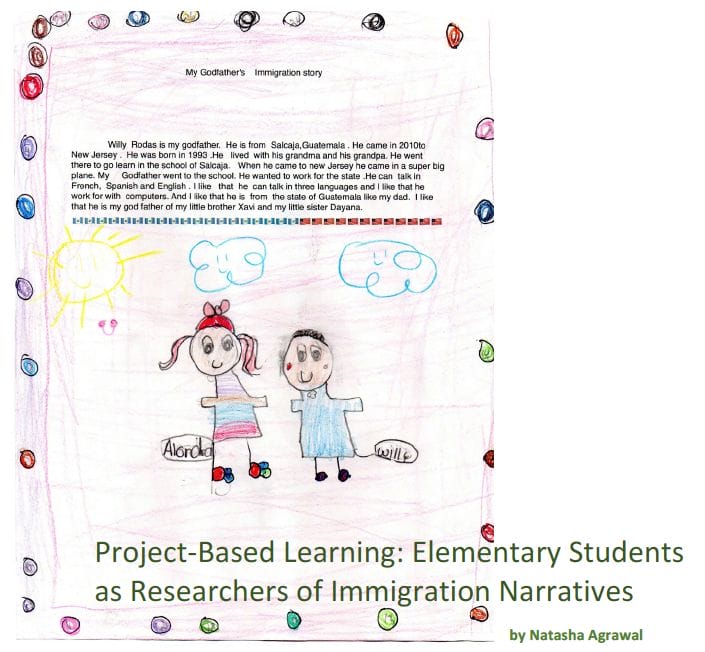
The more young people who get the opportunity to travel the world, live in other cultures and learn new languages, the more they will begin to understand our shared ideals and the shared opportunities to keep moving this world forward.
~ Michelle Obama1
Seeing the Between Two Worlds exhibit in Santa Fe at the Museum of International Folk Art inspired me to think about my New Jersey students’ journeys to the U.S. As an English as a Second Language (ESL) Teacher at Carroll Robbins Elementary School in Trenton, New Jersey, I wanted to design a curriculum that would inspire my students and meet learning goals for the classroom.
Many young people have traveled through deserts and across oceans to come to Trenton. As an ESL teacher at Robbins School, I am curious about and thankful for each child who walks through my classroom door. What are their experiences like? How do they feel about being immersed in a new culture? What strengths do immigrant children bring and how can teachers empower them to use those strengths?
With these questions in mind, I began an immigration project with my grade 3 and 4 after-school ESL students. I realized that the children were eager to talk about their experiences and their home countries. To facilitate interaction and collaboration, we began our project with conversations about our home countries and the languages we speak. Speaking and listening are integral domains of language learning. Additionally, the Common Core Anchor Standard 1 for Speaking and Listening defines that students should prepare for and participate effectively in a range of conversations and collaborations with diverse partners, building on others’ ideas and expressing their own clearly and persuasively.
Our immigration project concluded with presentations of written narratives as well as oral interviews recorded with iPads. I partnered the students so they could work together to interview each other and create a narrative about each other’s immigration experiences. Here are the steps of our project:
Step 1: Brainstorming questions for an interview
What would you like to know about your partner? For ESL students, using the right sentence structure for questions is often difficult. So we began with some easy questions. Where did you come from? Who was with you when you traveled? How did you feel? The children added many more to this list. What colors do you like? What games do you play? Were you afraid? Was your family rich or poor?
Step 2: Using technology
Common Core Speaking and Listening Standard 4 outlines that students should be able to make strategic use of digital media and visual displays of data to express information and enhance understanding of presentations. We used iPads to record interviews so our information was oral and visual. It was also easily accessible when the students needed to listen to the interview to clarify information to put into their written narratives.
Step 3: Integrating community
To involve the parents, we invited them to the classroom, asking if they would like to be interviewed by the children. It was a matter of great pride for the students to bring their parents in and have their immigration narratives recorded. The most interesting part was when the parent revealed certain details about their lives and travels, which their own child did not know. For instance, one little girl learned that her mother was a weaver and can speak Quechua. She glowed with pride when other students commented on how smart her mother was to be able to create such beautiful fabric and speak such a difficult language!
Step 4: Involving the school staff
Interestingly, many of our staff members also have fascinating immigration stories to tell. The students interviewed our principal who is from Dominican Republic, our custodian who is from Gambia and a teacher from India. Between them, they spoke and demonstrated a variety of languages. Through the interviews, students learned the names of several different languages, enhancing their understanding of the peoples and tongues all around the world.
Step 5: Written narratives
After all the information had been collected, each student picked one person to write about. According to Common Core Speaking and Listening Standard 3 students should be able to evaluate a speaker’s point of view, reasoning, and use of evidence and rhetoric. My students returned to the recorded interviews to glean information and type a narrative about a staff member, a parent, or their partner. Giving students a choice to select the immigrant narrative they want to write about develops decision making skills and creates accountability.
Step 6: Presentation
Once the narratives were printed out and the illustrations were complete, it was time to present! I instructed students to bring one artifact from their home cultures to add to their presentation. First, the children read aloud their writing about a new culture that they learned about, and then they presented an artifact from their own homes. There was undeniable pride in the students’ writing and presentation of their artifacts. From Ecuador, we got a big flag, from Haiti, a book in French. The Guatemalan girls brought handwoven huipils, and another little girl wore special shirt with a picture of Our Lady of Guadalupe.
Our immigration project created meaningful dialogue and deepened relationships between students, parents, and staff. Together we learned about traditions, food, and languages from different parts of the globe. It is by investing in similar projects that students will discover “shared ideals and shared opportunities to keep the world moving forward” that Michelle Obama espouses.

These narratives are written by 3rd and 4th graders, all ESL students who are level 2 and 3 (level 6 being native-like fluency).
Natasha Agrawal has been an ESL teacher in Trenton Public Schools for eight years. She enjoys teaching and learning from children who come to her classroom from all around the world.
1. Quote from CNN iReport Interview with First Lady Michelle Obama on the value of
study abroad experiences. See http://www.cnn.com/2014/03/25/
